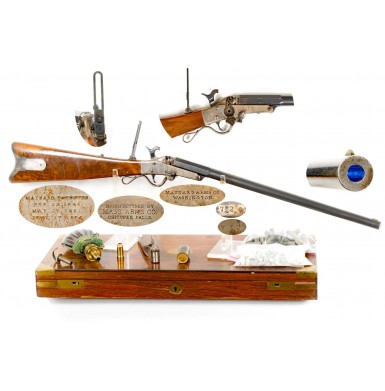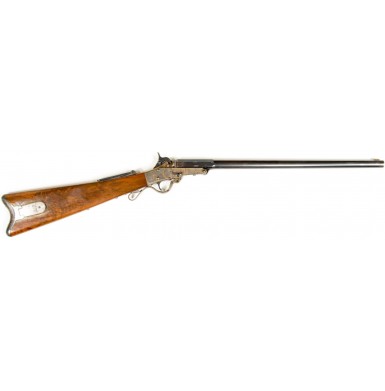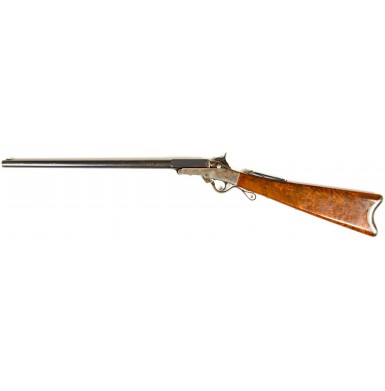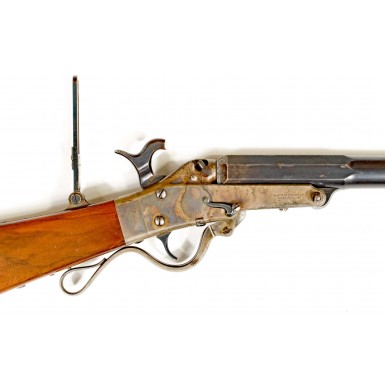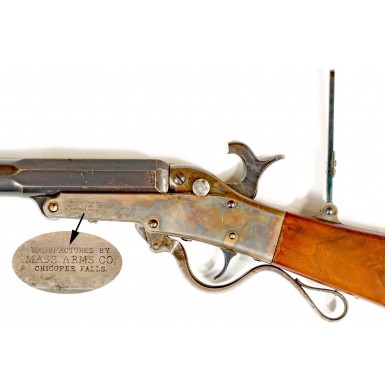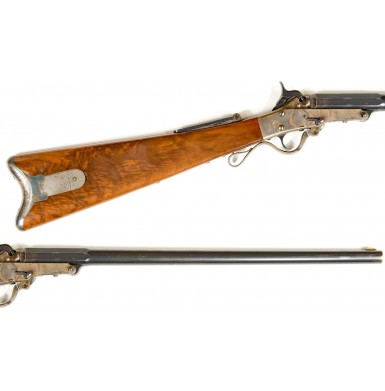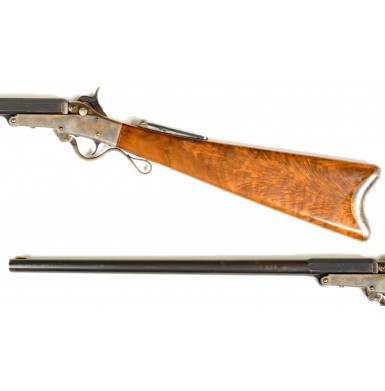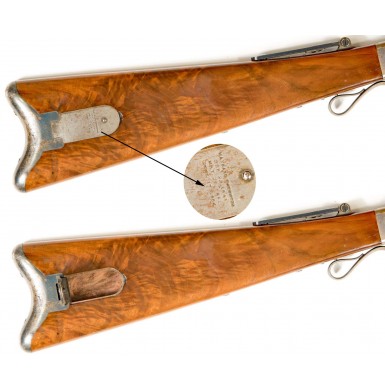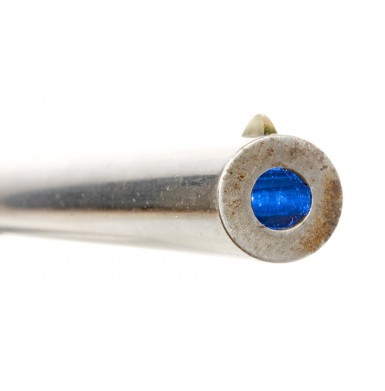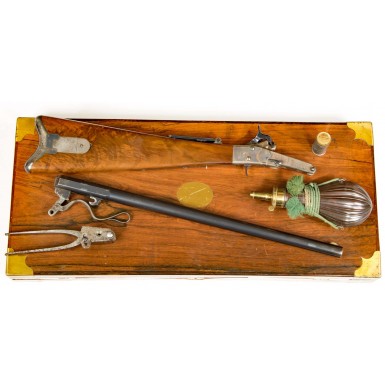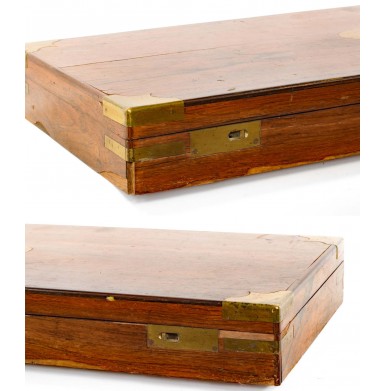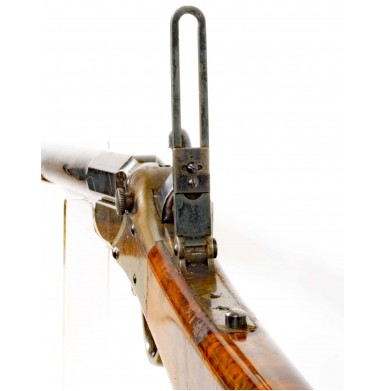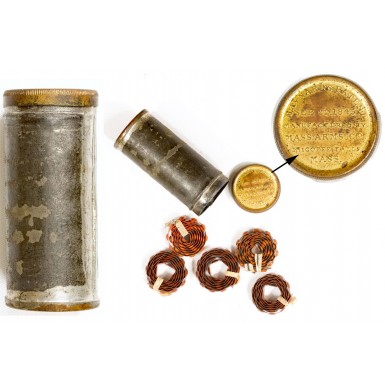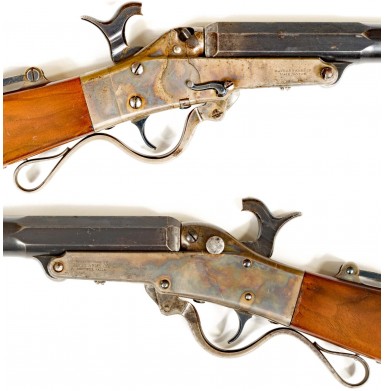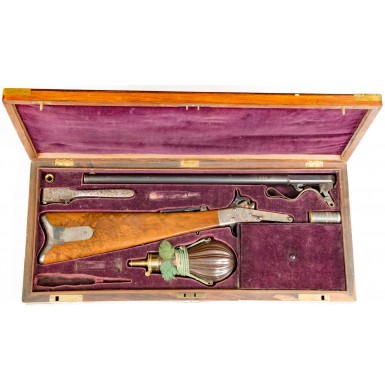Cased 1st Model Maynard Sporting Carbine
- Product Code: FLA-3545-SOLD
- Availability: Out Of Stock
-
$1.00
This is a wonderful example of a scarce and desirable fully cased 1st Model Maynard Sporting Carbine. These guns were the invention of famous dental surgeon and firearms innovator Dr. Edward Maynard. Dr. Maynard is probably best known for his invention of the Maynard Tape Priming System, an automated priming system that utilized a varnished strip of paper with small amounts of fulminate of mercury, similar to a modern day child’s cap gun. The system advanced the roll of primers each time the hammer was cocked, and upon firing, the hammer cut off the spent piece of primer tape. This system showed such promise and was so well thought of by the US Ordnance Department that the US Government paid Maynard $75,000 for the use of his priming system on the US Model 1855 series of arms. In addition to his tape-priming patent (#4,208, issued in 1845), Maynard received a total of twenty-three US patents related to innovations or improvements to firearms designs. Maynard’s carbine design was an innovative breech-loading firearm, which used a proprietary brass cartridge loaded with powder and a lubricated bullet and that utilized Maynard’s tape priming system for ignition. Maynard paid the Springfield Armory $116.37 in 1853 to produce a full scale model of his carbine, and this model was subsequently tested by the Ordnance Department in 1856 with very positive results. The successful trials resulted in the formation of the Massachusetts Arms Company in 1857, which was established for the purpose of producing Dr. Maynard’s breech loading long arm. The guns were produced in both carbine and rifle lengths, with 20” and 26” barrels respectively, and were offered in both .35 and .50 caliber.
The U.S. Army held additional trials of breech loading long arms in 1858, and the Maynard’s ease of operation and ability to function quickly and reliably helped to win the Massachusetts Arms Company a contract for 400 of the .50 caliber military pattern carbines. These guns were ordered with fixed sights only (no tang sight) and specified the use of a sling ring on the trigger plate tang, rather than on a traditional sling bar on the side of the carbine. These carbines were delivered in March and April of 1859. In late 1859, the US Revenue Cutter Service ordered an additional 200 Maynard carbines. While the first 100 arms ordered were referred to as “rifles”, it is believed that all 200 of these guns were in fact carbine length, chambered for the .50 Maynard cartridge. Then in February of 1860, the US Navy ordered 50 1st Model Maynard carbines, also in .50 caliber.
While the Massachusetts Arms Company pursued what they perceived to be lucrative US government military contracts, they also produced sporting versions of the rifle and carbine and offered them for sale to the general public. The guns were available in both barrel lengths and calibers as well as in cased sets, often with a second barrel, loading tools and a variety of optional accessories. While cased sets are far from common today, there appear to be two types; factory casings and retailer casings. Based upon the existence of a couple of factory presentation cased sets, it appears that the factory casings were form-fit, French-style casings. According to arms researcher, author and historian James D McAulay, a number of famous (and soon to be famous) Southerners purchased Maynard sporting arms. These men included South Carolina’s Wade Hampton, Georgia senator Robert Toombs and Vice President John Breckenridge of Kentucky; all of who became Confederate Generals during the American Civil War.
The initial production goal of the Massachusetts Arms Company had been 5,000 arms. According to McAulay, as of October 1, 1860 the company had sold approximately 1,400 guns and had a total of 3,527 arms in inventory. The inventory on hand was distributed as follows:
(326) 2nd Quality Arms (caliber and type unspecified)
(459) .50 caliber - 20” carbine barrel - Sporting configuration
(676) .50 caliber - 20” carbine barrel - Military configuration
(142) .50 caliber - 26” rifle barrel - Sporting configuration
(160) .50 caliber 26” rifle barrel Military configuration
(1,326) .35 caliber 20” carbine barrel - Sporting configuration
(425) .35 caliber 20” carbine barrel - Military configuration
(13) .35 caliber 26” rifle barrel - Military configuration
McAulay further notes that approximately 90% of this remaining inventory of 1st Model Maynard rifles and carbines were purchased by southern states and militia companies between October 1, 1860 and April of 1861. McAulay’s research indicates that the majority of the guns went to the states of Mississippi, Florida and Georgia. According to his figures, Florida acquired a total of 1,030 guns in December of 1860, all of which were carbine length (20”) and were chambered in .35 caliber. Mississippi acquired 800 guns in December of 1860 as well. Their purchase included both carbines (625 total) and rifles (26” barrel, a total of 175) and the guns were a mixture of .50 and .35, with all 175 of the rifles and 300 of the carbines being .50 and the remaining 325 carbines being .35. All 650 of the Georgia purchased guns were .50 caliber carbines. While Florida and Mississippi acquired their guns directly from the Massachusetts Arms Company, Georgia purchased their guns in January and March of 1861 from the firm of W.J. Syms & Brothers of New York City. Syms sold an additional 1,700 Maynards between October 1860 and May 1861. It is estimated that all but about 100 of these guns went to southern purchasers. McAulay notes that approximately 800 of these guns went South Carolina and Louisiana. The balance of the estimated 800 “Confederate” sales by Syms were apparently made to Kentucky and Tennessee in April and May of 1861.
A substantial number of Confederate regiments were at least partially armed with 1st Model Maynard rifles and carbines during the Civil War, resulting in the guns (in both barrel lengths and calibers) being listed in the 1863 Confederate Ordnance Manual as a standard issue Confederate carbine. Some of the Confederate units armed with the guns included the 1st and 6th Florida Special Battalion of Infantry, 2nd Florida Cavalry, 5th & 9th Georgia Cavalry, Cobb’s Legion of Cavalry (Georgia), 1st Louisiana Cavalry, 11th Louisiana Infantry, 1st & 4th Mississippi Cavalry, 9th, 14th & 15th Mississippi Infantry, 18th North Carolina Infantry, 3rd Tennessee Cavalry, 35th Virginia Cavalry Battalion and the Waccamaw South Carolina Light Artillery. Some 1st Model Maynards were also issued to the Confederate ironclad CSS Atlanta. The production of the 1st Model Maynard was brought to an end by a fire at the Massachusetts Arms Company factory in January of 1861. Dr. Maynard proceeded to buy out all of the various partners and owners of the company in 1862, and by 1863 the factory was back in business, producing the 2nd Model Maynard Carbine for the US Ordnance Department.
This Cased 1st Model Maynard Sporting Carbine is in about NEAR EXCELLENT condition overall. The gun is a 20” barreled, .35 caliber, sporting configuration carbine. It has the very low serial number 724, suggesting it was an early civilian model, as the first 600 or so 1stModel Maynards were part of US military contracts. The gun is 100% complete and correct and is contained in what appears to be a factory produced, French fitted case. The gun is mechanically excellent and fully functional in every way, including the somewhat temperamental Maynard Tape Priming System. The action of the carbine remains crisp and tight, with solid and secure lock up. The carbine is clearly marked in two lines on the lower right side of the frame: MAYNARD ARMS CO. / WASHINGTON. It is additionally marked on the lower left side of the frame: MANUFACTURED BY / MASS. ARMS CO. / CHICOPEE FALLS and on the patchbox door: MAYNARD PATENTEE / SEP 22 1845 / MAY 27 1851 / JUNE 17 1856. There is no paper Maynard label in the patchbox and does not every appear to have been. As noted, the carbine is serial number 724 and is clearly marked with that number inside the tape primer door and on the bottom of the barrel, concealed by the frame.
As previously noted, the gun is in really outstanding condition. The frame retains about 80%+ pf the original, vivid case hardened colors. The colors are slightly less vibrant on the obverse of the frame, particularly on the forward portion. The frame shows some light pinpricking, primarily around the breech area and near the percussion bolster, all from the caustic mercury in the primer pellets. Some similar light pinpricking, and minor oxidation is present around the breech of the barrel as well. The original cone (nipple) is in place and remains quite crisp and in very good condition. The barrel retains about 90%+ of the original blued finish, showing only some minor thinning, fading and wear. Most of the loss is due to handling and use, with wear along the sharp edges of the breech section, scattered thinning and fading typical light wear. The metal is almost entirely smooth, with only some lightly scattered flecks of light surface oxidation, as well as some tiny patches of pinpricking and minor peppering. The large rounded buttplate a retains some strong traces of original blue, with significant wear and loss and scattered surface oxidation giving the metal a mottled brownish gray appearance. The patchbox retains none of its finish and has a medium pewter gray patina with flecks of scattered surface oxidation and discoloration.
The gun is in the “sporting” configuration and does not have a sling ring on the rear of the trigger plate tang. There is no fixed rear sight on the barrel, as was standard on the military configuration guns. Only the adjustable sporting tang sight and factory front sight blade are present, as is correct for a “sporting” configuration gun.
The bore of the carbine is in NEAR EXCELLENT condition as well. The bore is bright and shiny, and retains fine, crisp rifling. The bore shows only some light to moderate scattered frosting in the grooves, and some minor, scattered pinpricking. One of the unique features of the 1st Model Maynard carbine was the ability to adjust the headspace of the gun, by adjusting the relationship between the barrel breech and rear of the frame. This was accomplished by the means blocking wedges which could be moved slightly by turning two screws located at the bottom of the frame, forward of the trigger guard. These screws remain in find condition and are often found well-worn or damaged. The buttstock is in VERY FINE+ to NEAR EXCELLENT condition. The stock made from a highly figured piece of walnut that has an almost flame-like grain. The stock has a lovely factory applied varnish finish. It retains most of this factory finish, with only some light wear and some finish scuffs. The wood of the stock is solid and free of any breaks, cracks or repairs. The buttstock shows the usual minor bumps and dings from handling and use but shows no abuse or damage.
The gun is contained in mahogany veneered, French fitted case with dark burgundy crushed velvet lining. The case has form fit compartments for a variety of accessories, some of which are still present. Included in the case are the original and correct American Cap & Flask Company powder flask with the original green lanyard, the original single-cavity iron bullet mold, an original, partially filled tin of Maynard tape primes and numerous used Maynard brass cases and heavily oxidized lead bullets. The flask is in VERY FINE condition with most of the finish intact and showing only some light handling marks. The flask is well marked on the top and remains fully functional. The original green lanyard cord shows moderate wear and loss but remains present. The bullet mold is well-marked and has a medium pewter patina with a moderate amount of speckled surface oxidation over most of the surfaces. The mold cavity remains crisp and mostly bright with a couple of small spots of minor oxidation that could probably be cleaned away if desired. The primer tin is moderately oxidized, and the embossed brass lid retains only some traces of the gilt finish. The markings on the lid remain clear and legible. The tin contains five partial rolls of Maynard primers that are no longer in their wax paper wrappers and are secured with old twist ties. The primer tapes are all in good condition, showing typical age and light handling wear. The brass cartridge cases all show light to moderate use, as well as light to moderate oxidation. The bullets are in fair condition, heavily oxidized and some are actually disintegrating. Both the cases and the bullets have been placed in plastic bags to contain their oxidation and keep them from creating a mess in the case. The cases and bullets are all stored in the large, lidded compartment of the case. There are three empty tool sections in the case, which originally contained the turnscrew (screwdriver) and loading tools for the case. These are no longer present and are lost to the ages.
The case is in about GOOD to NEAR VERY GOOD condition. As is so often the case, the case itself shows the most wear and age. The mahogany veneer has chipped and worn in numerous places with small pieces of it missing here and there, some repaired cracks in the veneer and some areas where the cracked veneer is now loose. There are some grain cracks in the case as well, with a large one clearly visible on the right side of the lid and other small ones here and there, as well as in the soft wood bottom. There is also a piece of wood missing from the left front corner of the case. The case is brass mounted with Bible style hinges and two sliding latches on the front face. There is a lock for the case, but no key is present. There is a brass escutcheon plate in the top of the lid that has not been engraved. The casing has been refinished on the exterior with an added layer of varnish, over both the wood and the mountings. The case shows scattered bumps, dings and mars, in addition to the veneer and wood loss already mentioned. The interior of the case remains in VERY GOOD, with the compartments and dividers all remaining solid and in good repair. The lining shows some fading and wear but remains in very nice condition with a lovely burgundy color. Overall, despite the exterior damage, the case is really very nice and displays the gun wonderfully.
Overall this is a really outstanding, all original and extremely attractive example of a Cased1st Model Maynard Sporting Carbine. The gun is in fine mechanical condition, has a great bore and is as complete correct and original as one could hope to find with lots of original finish. It remains in its original factory casing with the major original accessories, including the flask, mold and primer tin, all remaining in fine condition as well. The only detractions at all are three small missing accessories and some exterior wear to the case, none of which really affects the fantastic eye appeal of this cased set. This cased set came out of a family collection in Maryland just recently and some information about its former owners will be shared with the new owner. There is no Civil War history or provenance regarding the users of the gun during the 19thcentury, but the story about one of the 20thcentury owners is quite interesting, and some family paperwork about the gun will be included with it for the new owner. Rarely do Factory Cased 1st Model Maynard Sporting Carbines come up for sale, and this one is a real beauty, worthy of being a part of any advanced collection.
SOLD

